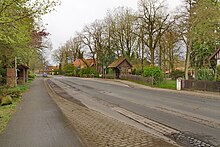Farster peasantry
|
Farster Farmers (FB)
Isernhagen municipality
|
||
|---|---|---|
| Coordinates: 52 ° 28 ′ 14 " N , 9 ° 50 ′ 28" E | ||
| Height : | 84 m above sea level NHN | |
| Area : | 6.05 km² | |
| Residents : | 1456 (December 31, 2018) | |
| Population density : | 241 inhabitants / km² | |
| Incorporation : | March 1, 1974 | |
| Incorporated into: | Warmbüchen | |
| Postal code : | 30916 | |
| Area code : | 05139 | |
|
Location of Farster Bauerschaft (FB) in Lower Saxony |
||
|
View of the hill of the Farster peasantry from the direction of Hohenhorster peasantry (HB)
|
||
The Farster Bauerschaft (FB) is a district of Isernhagen in the Hanover region in Lower Saxony . It represents the eastern end of the horseshoe, as the old villages of Isernhagen are called due to their geographical shape.
geography
The Farster peasantry is located on a ridge on which the other Isernhagen districts of Niedernhägener peasantry and Kircher peasantry are lined up. In FB is at 84 m above sea level. NHN. the highest point in the parish. The elevated location gave its name to the "Farster".
The town of Burgwedel is located north of the Farster peasantry , to the west is the Hohenhorster peasantry , south of the Kircher peasantry and east of the Neuwarmbüchen .
history
The Farster farmers are a place that was laid out as an elongated Hagenhufendorf village as early as the Middle Ages . The designation as a peasantry is based on the economic form of Burschap ( peasantry ), which is common in Low German areas . The name was first mentioned in 1442 in the registers of the Burgvogtei Celle . The term Farster in the name of the place comes from the historical name Dachfarst for roof ridge . The place was named because it is the highest of the four Isernhagen old villages.
On March 1, 1974, the community of Isernhagen, Farster peasantry was incorporated into the new community of Warmbüchen. This was officially renamed Isernhagen on June 1, 1975 .
politics
Local council
The local council of the Farster farmers consists of a councilwoman and four councilors. The local council also has two advisory members ( AfD , non-party ) .
(Status: local election September 11, 2016)
Local mayor
The local mayor is Angela Leifers (CDU). Your deputy is Emil Brockstedt (CDU).
coat of arms
The draft emblem of Farster peasantry comes from the in Isernhagen born and later in Hannover living heraldry and crest painter Gustav nations , which includes the coat of arms of Großburgwedel , Melle village , Wunstorf has designed and many other towns. The award of the coat of arms was carried out on November 22, 1954 by the Lower Saxony Minister of the Interior .
| Blazon : “A blue , right sloping beam in silver , covered with four upright, mutually covering, silver horseshoes . In the upper corner a sloping, green ear of wheat to underline the agricultural character. " | |
| Founding of the coat of arms: The name Isernhagen is evidence of iron ore deposits that were proven to have been exploited here as early as around the year 900. This is what the horseshoes indicate. They should also remind you that horse breeding has been practiced successfully in Isernhagen for a long time. The number of four horseshoes was chosen to show the close ties between the independent political communities that make up a parish and a settlement unit. The blue, right sloping bar is supposed to symbolize the river Wietze . The coats of arms of the four municipalities must be viewed together, especially since the municipalities tried very hard to give themselves a uniform coat of arms. At the request of the Lower Saxony Minister of the Interior, however, each municipality had to include a distinctive symbol in its coat of arms. |
Culture and sights
Buildings
Today the townscape is characterized by a large number of very old, well-kept half-timbered houses and farms, which have often been redesigned for modern use.
Architectural monuments
→ See: List of architectural monuments in Farster peasantry
Photo gallery
literature
- Claudia Kempf-Oldenburg, Jes Tüxen: Isernhagen Chronicle Volume 1. Ed .: Community Isernhagen, 1990
- Claudia Kempf-Oldenburg, Jes Tüxen: Isernhagen Chronicle Volume 2. Ed .: Community Isernhagen, 1992
- Heinz Koberg : Our Isernhagen. Ed .: Municipality of Isernhagen, 1984
Web links
Individual evidence
- ↑ a b Facts and Figures. In: Website of the community Isernhagen. December 31, 2018, accessed April 17, 2019 .
- ^ Federal Statistical Office (ed.): Historical municipality directory for the Federal Republic of Germany. Name, border and key number changes in municipalities, counties and administrative districts from May 27, 1970 to December 31, 1982 . W. Kohlhammer, Stuttgart / Mainz 1983, ISBN 3-17-003263-1 , p. 222 .
- ^ Federal Statistical Office (ed.): Historical municipality directory for the Federal Republic of Germany. Name, border and key number changes in municipalities, counties and administrative districts from May 27, 1970 to December 31, 1982 . W. Kohlhammer, Stuttgart / Mainz 1983, ISBN 3-17-003263-1 , p. 197 .
- ↑ a b Local council of the Farster farmers. In: Website of the community Isernhagen. Retrieved August 14, 2017.
- ^ A b Landkreis Hannover (ed.): Wappenbuch Landkreis Hannover . Self-published, Hanover 1985, p. 198-199 .







